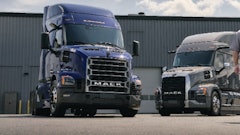
This fall has been a busy time for heavy-duty pickup manufacturers. Sales have been climbing and they have responded by pulling the wraps off even more capable models. The changes have been much more than cosmetic, with increased tow ratings, improved suspensions and further refinements. Let’s take a look at the new class of heavy-duty pickups.
Ram Adds Capability for 2014
With the 2500 and 3500 pickups, Ram Truck has set a new bar for towing capability. “We took the GCWR of our heavy-duty pickups and chassis cabs to 37,600 lbs.,” says Dave Sowers, head of Ram Truck light-duty and heavy-duty marketing. “That leaves us with a trailer towing capacity of 30,000 lbs.”
The 2014 Ram 2500 features a new frame that incorporates the three-link front suspension from the 3500. This suspension has a long radius arm and three large canned bushings, two on the axle and one on the body. It provides roll stiffness for increased towing and payload capacity. New 18- and 20-in. wheels are also included across the heavy-duty pickup line.
The 2500 also uses a five-link coil rear suspension that helps reduce friction without sacrificing towing capability. This results in better ride quality. “We have increased the GVWR on this truck (gas and diesel) to 10,000 lbs.,” says Kevin Mets, head of Ram Truck heavy-duty pickup engineering. “So we are delivering payloads of nearly 4,000 lbs.”
The five-link coil design incorporates support at all major points of force and resists unwanted axle rotation. It weighs 40 lbs. less than the leaf-spring configuration, while allowing U-joints and driveshafts to run smoothly.
In addition, Ram plans to introduce rear air suspension on the 2500 and 3500 pickups. “On the 2500, we will replace the coil springs with the air suspension, and on the 3500, we will have leaf springs with air bag helpers,” says Sowers. The automated rear air suspension system levels the load to improve stability.
A front-axle disconnect on the front axle of 4WD models aids fuel efficiency. Select drivetrain components are disconnected, improving fuel efficiency by up to 1 mpg.
The Cummins High-Output Turbo Diesel allows you to make the most of the increased towing capacity with 850 lbs.-ft. of torque and 385 hp.
But the big news is the new 6.4-liter gas engine. It was designed to be a truck engine right from the start. “It meets all of the durability requirements that we run on our diesel. It has an active air intake and generates 410 hp and 429 lbs.-ft. of torque,” says Sowers. “The active intake system provides that low-end torque that you need in a pickup truck engine, but it also gives you that high-end power. When you look at the torque curves, what is really great about this engine is it delivers the torque you had in the 5.7-liter about 800 to
1,000 rpm sooner.”
This engine will also feature MDS, which allows the vehicle to go into four-cylinder mode whenever it can for added fuel savings.
GM Increases Towing Confidence
For 2015, the Chevrolet Silverado and GMC Sierra HD pickups will offer new exterior styling, integrated cruise control, Auto Grade Braking and Diesel Exhaust Braking on diesel models; standard Stabilitrak Trailer Sway Control; 6.5- and 8-ft. boxes with standard CornerStep bumpers; EZ Lift and Lower tailgates; and new cabs and interiors.
The new exterior enhances aerodynamics for improved efficiency and reduced wind noise. It also improves cooling for more consistent power under tough conditions. Inlaid doors fit into recesses in the body side to help reduce cab noise. The roof and tailgate spoiler were tuned in a wind tunnel to smooth airflow over the truck for reduced noise and improve aerodynamic efficiency. Particular attention was paid to airflow for both the engine cooling and engine air intakes.
Towing was also a top design goal. GM made refinements to the cruise control, Auto Grade Braking and Diesel Exhaust Brake to inspire a new level of confidence. The Auto Grade Braking is activated by pressing and holding the tow/haul button for three seconds. The transmission then automatically downshifts when needed to help slow the vehicle. When using the Duramax diesel, the driver can engage the Diesel Exhaust Brake, which uses the variable vanes in the turbocharger to create additional backpressure in the engine to help slow the vehicle.
The combination of the exhaust brake and the automatic transmission downshifts help the driver maintain the desired speed, even on long, steep highway downgrades. Stabilitrak with Sway Control is now standard on all Chevrolet Silverado and GMC Sierra models, including the 3500HD dually.
Payload and towing capabilities have increased from the 2014 HD models. Maximum available payload is now 7,374 lbs., maximum available conventional towing is 19,600 lbs. and maximum available fifth-wheel towing is 23,200 lbs.
A bi-fuel version of the 6.0L V8 — with special hardened valves and valve seats to enable operation on gasoline or compressed natural gas — will be available in all three models of the new Silverado HD (regular cab, crew cab and double cab). Chevrolet will continue to work with a second-stage manufacturer to offer a single-source option for its CNG vehicles.
The bi-fuel trucks are built with the specially designed engine, the fuel system is installed by GM’s Tier One supplier and the completed vehicle is delivered directly to the customer. This process makes ordering the bi-fuel option as seamless as ordering a truck powered by gas or diesel, and ensures the highest level of durability, reliability and safety.
Ford Upgrades Super Duty Line
Ford introduced the 2015 F-Series Super Duty pickup truck line at the State Fair of Texas. The 2015 models will feature a second-generation 6.7-liter Power Stroke V8 turbo diesel engine, increased towing capabilities and a refreshed, Texas-inspired King Ranch model.
A key innovation on the original Ford 6.7-liter Power Stroke V8 turbo diesel that debuted in 2011 was its “reverse-flow” layout. This advanced design places the exhaust inside the engine’s V-shape with the air intake positioned on the outside of the V. This segment-exclusive design naturally improves various attributes, including:
•Shorter airflow from the exhaust system to the turbocharger sitting between the engine’s cylinder banks improves turbo responsiveness, providing torque quickly to truck customers when it’s needed most.
•Positioning the turbo inside the engine’s valley helps isolate the engine’s hottest temperatures, improving performance and efficiency, while also reducing noise, vibration and harshness.
Ford engineers have built upon the benefits of this design as they upgraded the Power Stroke. One improvement is a larger GT37 turbocharger that replaces the previous GT32 model, enabling more airflow to the engine to produce more power beyond today’s 400 hp and 800 lbs.-ft. of torque.
The GT37 features a single, larger 88 mm compressor wheel that replaces the GT32’s dual-sided compressor design. The compressor forces air into the engine’s cylinders to improve performance, especially at high altitude. The turbine size is increased to 72.5 mm from 64 mm, so exhaust gases have a larger surface area to spin the turbo, providing extra power. The wastegate and wastegate controls are eliminated, since the turbo operates at lower peak pressures than the GT32.
A further benefit of the larger turbo is improved engine exhaust braking, manually controlled by a push-button switch on the dashboard. Extra braking power helps reduce wear and tear on wheel brakes and requires less manual brake application from the driver, especially on downhill grades.
Turbo changes drove improvements to the fuel delivery system — specifically, a new high-pressure fuel pump and fuel injectors. The pump’s cam stroke is increased to deliver more fuel when desired for increased power. All-new injector tips better atomize the fuel, resulting in improved combustion that enables lower noise, vibration and harshness. Other benefits include cleaner emissions and a reduction in the buildup of fuel deposits on the valves over time.
In addition, a new exhaust temperature sensor enables more accurate fuel control, which improves both durability and driveability, especially when towing, and helps the customer drive the Power Stroke diesel to its maximum capability.
While the fuel system delivers extra fuel as needed to provide more power, other efficiency improvements ensure 2015 Ford F-Series Super Duty pickup customers see similar fuel economy performance.




















